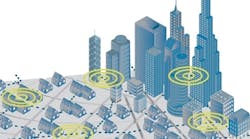A global tipping point in population location is offering an opportunity for technology to solve the issues that cities are facing.
The United Nations reported that in 2008 the urban populace crossed 50% of the world’s total population.
By 2050, it is predicted that 64% of the developing world and 85% of the developed world, will be urbanized.
These numbers will create quite a challenge on our cities in terms of transportation, public utilities and other services.
One answer to this problem is the creation of a “Smart City”. A smart city utilizes innovative solutions to simplify complex problems and provide the infrastructure and the blueprint for growing cities to safely, intelligently and pragmatically scale.
As they move from concept to reality, smart cities will increasingly deploy information communication technology (ICT) in planning, backed by analytics and tracking usage in real-time, so that these amenities are used in a more intelligent way to maximize effectiveness and utilization.
Take the example of personal transportation where powerful navigation systems deploying GPS, have simplified city driving. Imagine scenarios wherein navigation system can help drivers reach their destination, avoiding traffic congestion, taking them to parking lots with available space or gas stations after sensing they are nearly out of fuel.
Personal transportation solutions are poised to take a quantum leap beyond these examples. As they are more integrated into the traffic infrastructure of a city, these systems can provide drivers with more real-time information, ultimately culminating in autonomous cars, as both cities and vehicles get smarter.
Technology for Evolving Infrastructure
This evolving infrastructure could include intelligent traffic signals, sensors, active lanes, communication, etc. And as smart devices are increasingly integrated into a city's infrastructure through the effective deployment of ICT, they can make commuting and navigating in a city a lot more seamless.
For example, Intelligent Traffic Management systems will use roadside sensors, cameras, automatic number plate recognition systems, wireless communication technologies and big data analytics, to track the traffic in arterial highways and roads. Connected traffic infrastructure with analytics will increasingly improve traffic flow and prevent snarls and pileups. Navigation systems deployed in a smarter city can proactively predict most congestion and help ease the same by diverting the traffic through alternate routes.
Traffic management for an integrated multi-mode public transportation in the context of large cities, is even more challenging. The complexities are manifold since the variety of transport vehicles in many cities around the world is high. Networked Transportation Systems facilitate the easy integration of multiple systems in smart cities.
Real-time communication allows easy synchronization of trains and buses thereby, ensuring a shorter commute home. Simple availability of online information regarding bus and train schedules, can help in personal time-planning. A city's smart traffic infrastructure with effective usage of ICT, is an obvious and immediate example of smart cities.
The applications of smart cities will go beyond these examples of revolutionizing transportation in improving quality of life. Traffic cameras with license plate and facial recognition systems, can help streamline traffic but also improve the overall security in smart cities. Networking with security cameras of adjacent corporate and government buildings and human identification techniques, can be used to improve security throughout the networked city.
The next biggest impact that smart cities can create is on energy and utilities (planning, distribution and consumption). For this to happen, a comprehensive integration of ICT is required in buildings, homes, smart power grids, hospitals, schools, etc. E-governance will become a necessity and basic hygiene to bring excellence and smartness in public services. Smart homes are an integral part of smart cities and when connected to cities public infrastructure, can bring out efficiencies. Obviously, all of this will come at a cost. People living in smart cities need to be more compliant for the city's community to derive the maximum benefits.
Since life in smart cities will capture the digital footprint of the citizens, it is likely to give rise to problems like individual privacy, information theft and misuse. While there are no easy solutions to these issues, upfront planning, awareness and education can improve security and keep misuse in check. In the end, the positives of automation and digitization far outweigh the negatives.
GH Rao is president – of the Engineering and R&D Services business for HCL Technologies.



